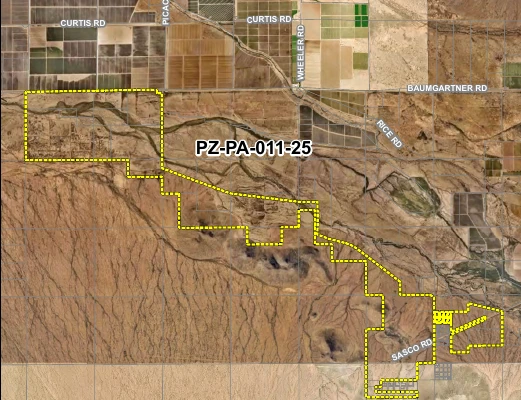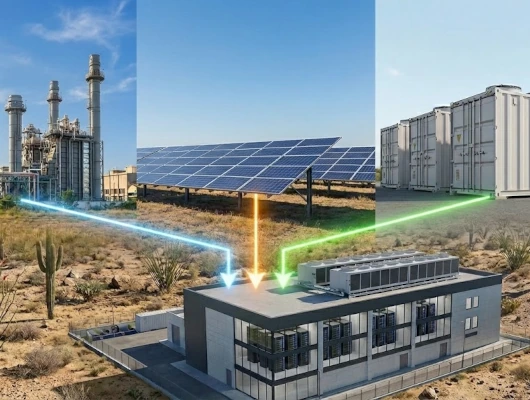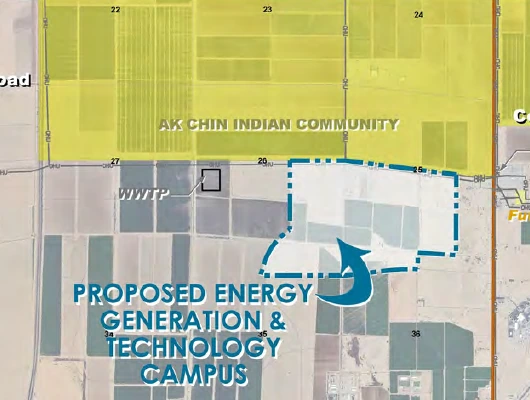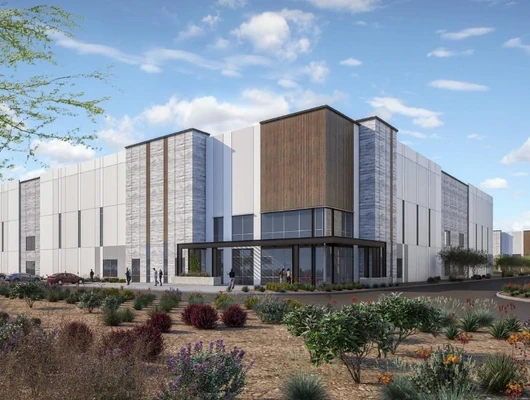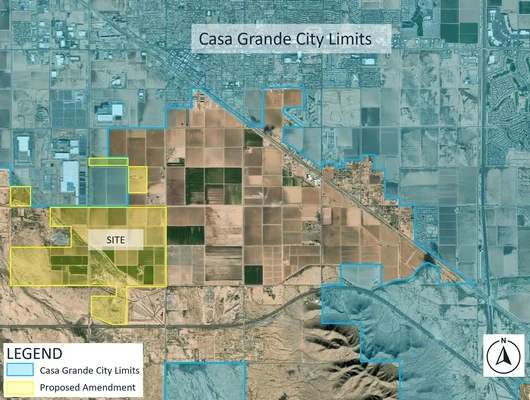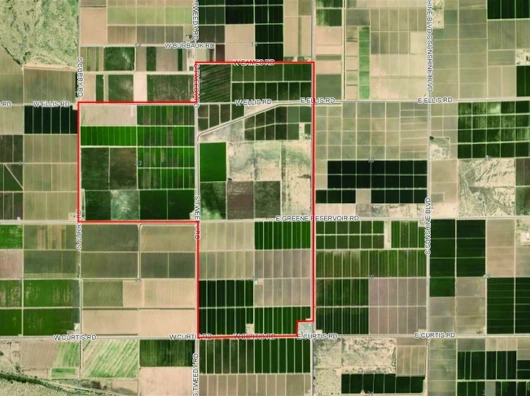Planning and Zoning Commission recommends approval of 3,374-acre complex
The Pinal County Planning and Zoning Commission voted 7-3 on October 16 to recommend approval of the La Osa Project’s comprehensive plan amendment. The vote marks the first step in a multi-stage approval process for the massive Pinal County data center and gas-fired power plant proposal.
The comprehensive plan amendment does not approve the project itself. It changes the land use designation for 3,374 acres from residential and open space to employment, general public facilities/services, and open space. If the Board of Supervisors approves the amendment on November 19, developer Vermaland LLC would then need to secure rezoning approval, followed by site plan approvals, before any construction could begin. Each subsequent stage would require detailed engineering studies, flood mitigation plans, environmental assessments, and infrastructure improvement plans.
The commission’s recommendation follows a previous work session covered by Pinal Post in July, where commissioners first expressed serious concerns about the flood-prone site’s impact on wildlife and sensitive wash areas.
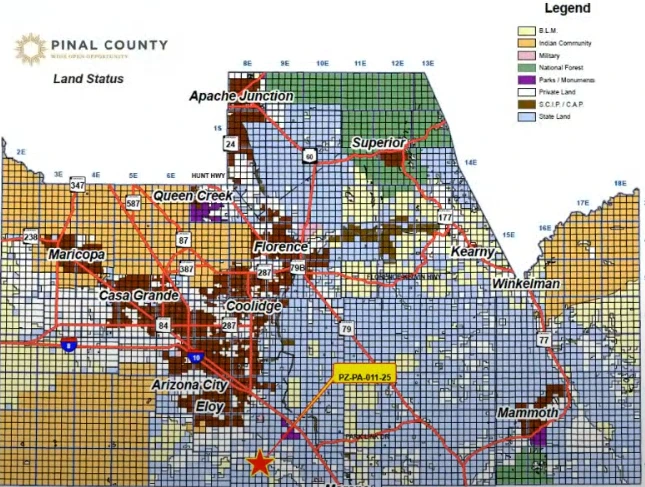
Over a Billion in Tax Revenue Projected
Court Rich of Rose Law Group, representing developer Vermaland LLC, made an emphatic case for the economic benefits the project would generate for Pinal County.
“This project is going to be tens of billions of dollars. There will be billions of dollars of equipment in each of these buildings and there’s an economic study that’s ongoing but we expect over 25 years it’s gonna be more than a billion dollars, way more than a billion dollars in tax revenue that comes off of this project,” Rich told commissioners. “And that is for the local school districts, for the fire districts, for the county. That is a tremendous opportunity to spread the wealth on those taxes and lower everybody else’s taxes.”
Rich emphasized that while data centers don’t create manufacturing-level employment, the project would still generate substantial job opportunities. “I know some people have a misconception that data centers don’t bring jobs. I will freely admit, it’s not a manufacturing plant. It’s not that many jobs. But it is hundreds, if not thousands of jobs at build out and that creates other jobs, indirect jobs that are a part of this.”
Water Use Clarified
Addressing concerns that dominated opposition testimony, Rich stated the developer commits to using air-cooled or closed-loop cooling systems rather than water-intensive evaporative cooling technology.
“The developer is committed to using what they call air-cooled or closed-loop cooling systems, so it will not be a water-cooled data center,” Rich explained. “This will not be a data center that’s cooled by water technology. The applicant will be stipulating to that with the county when it comes time for zoning.”
Rich emphasized this distinguishes the project from controversial proposals elsewhere. “This is gonna use less water than a residential development, it’s gonna use less water than if it were a farm.”
Energy Infrastructure and Power Generation
The project plans to build its own gas-fired power generation facilities on site. “And they’re gonna be building power plants as a part of this facility to help power themselves,” Rich said.
The developer must extend natural gas pipeline infrastructure approximately five miles from an existing pipeline to the west. Rich referenced recent announcements that “our state’s utilities are bringing in a new gas transmission line from Texas, so they’ll be bringing in a lot more natural gas which will enable projects like this to move forward.”
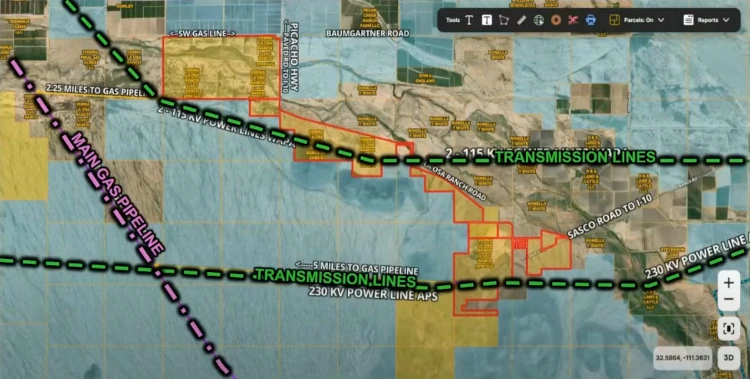
Regarding cooling for the gas turbines, Rich explained the facilities would use “minimal water for cooling” in what would likely be “a simple cycle gas plant, which means it’s just an engine that turns a turbine.”
Extensive Questioning on Energy Details
Commissioner Tom Scott engaged in detailed questioning about the energy generation component. When asked if the electricity produced would primarily serve the data center, Rich confirmed: “That’s correct.”
Scott pressed on whether the power would remain in Pinal County. “Absolutely, yes,” Rich responded, noting the project’s partnership with Electrical District 4 means “to the extent there’s excess that’s created, we anticipate that would be used within ED4’s district as well.”
On generation capacity, Rich acknowledged specifics remain undetermined. “The number’s not set and that’s because we have to work with ED4 to determine what they can serve and what they need,” he said. “But we’re certainly planning on hundreds of megawatts of gas in that location, if not more.”
Commissioner Bryan Hartman asked about battery energy storage systems and solar panels. Rich clarified the project currently has no battery storage planned and is not a solar project.
Chairman Expresses Skepticism
Chairman Morris Mennenga raised concerns about the project’s viability, citing conversations with prominent industrial realtors who expressed doubt about placing a data center “in the middle of nowhere south of Eloy.”
“We obviously don’t have the demographics in Pinal County or the education to even begin to staff a data center like this,” Mennenga said. “Years ago, I worked on economic development. We lost a lot of projects in Pinal County ’cause we just didn’t have the staff or the people in education to run those.”
Mennenga also expressed concern about flood risks, noting the Santa Cruz River’s history. “About 30 years ago, I worked at the Maricopa High School gym when they had five feet of water in the gym from the Santa Cruz River. The Santa Cruz River is… I mean, that thing can flood just about anything it wants to.”
Despite his concerns, Mennenga voted in favor of the recommendation. Rich responded that Arizona State University’s programs and the project itself could help develop needed workforce. “Projects like this have a tendency to help spin-off programs at community colleges and things like that,” he said.
Public Comment: Strong Support from Neighbors, Opposition from Environmental Groups
Staff received 27 letters in opposition and nine letters in support. Opposition letters raised several environmental concerns. These included potential negative impacts to Ironwood Forest National Monument, alterations to desert ecology and wildlife habitat, and Greene Wash pollution. Opponents also cited water usage, increased utility bills for residents, and questioned whether the job creation justified the vast area of desert land affected. The Citizen Advisory Committee had previously recommended approval with an 11-4 vote on September 4.
Adjacent Landowners Express Strong Support
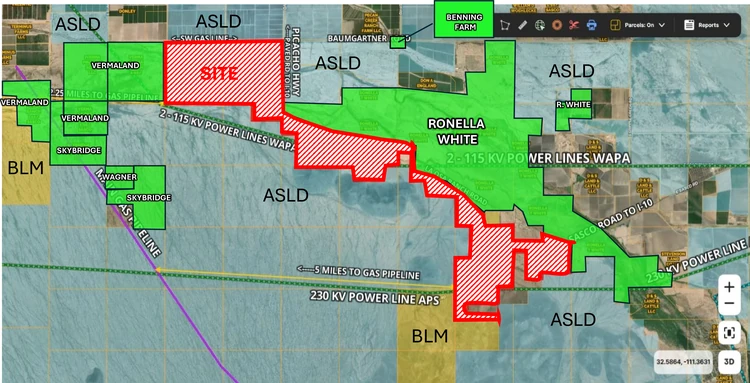
Dave Lamoreaux owns 640 acres immediately north of the project at Pecan Creek Ranch Farm. The fourth-generation farmer and rancher has owned the property for 21 years. He described the area’s need for economic development and detailed infrastructure failures and lack of services.
“When I bought that farm 21 years ago, my son and I came down there and started farming, and we had a problem with some law enforcement down there,” Lamoreaux said.
He described calling for help: “We called Pinal County, ‘We need some help down here.'” The response, he said, was that they were too far south and out of the service area.
“That’s Eloy, so we called Eloy,” Lamoreaux continued. The response he received: “Oh, no, you guys, we’re a big believer in the Second Amendment. You guys handle what you have to down there.”
“And I’m going, ‘This is backwards. This is archaic,'” Lamoreaux said.
He noted that a paved road from Picacho Highway to Wheeler Road “fell apart, started going potholes. County didn’t have any money, they didn’t repair it, they didn’t fix it. They let it go completely shot till they graded the asphalt off and it’s back to dirt road.”
Lamoreaux argued the area desperately needs development. “Things are backwards. We don’t have the education down here we need,” he said. Despite acknowledging the project’s challenges, he was enthusiastic about its potential impact. “You ought to kiss every one of these guys right on the lips. This would be the best thing that could ever happen for Pinal County.”
Ronella White, who owns approximately 4,000 acres adjacent to the project, said the land is “marginal, it wouldn’t be good for housing” and the project “would bring some jobs and economic development to our area.”
Fire Services Support
Arizona City Fire Chief Jeffrey Heaton expressed support, noting his district is working to expand service to the area. “We consider this one of our strategic business partners, and not only can we support this project, but we could also support fire and life safety services to the members of this community and county as well,” Heaton said.
Environmental Opposition
Environmental concerns dominated opposition testimony. Cyndi Ruehl, a desert ecologist and 40-year Pinal County resident, emphasized the ecological significance of the area.
“Did you know that of the 33 deserts of the world, this desert right here, the Sonoran Desert, is the most bio-diverse desert in the world,” Ruehl told commissioners. “And Pinal County has some of the last pieces of that bio-diverse desert.”
Ruehl stressed the importance of the wildlife corridor that crosses the property. “I am not saying that we don’t need data centers, we don’t need green energy. I’m not saying not to develop Pinal County, but we’ve got to be really careful about where we do this kind of development.”
She explained the corridor’s function: “Think about a corridor as an artery. An artery moves things through, so the corridor we’re talking about here moves water, of course, soils, genetics, seeds, wildlife, things that feed all of the ecosystems around it down to Tucson, up into Maricopa.”
Rich responded that the project preserves all currently designated open space and adds approximately 900 acres of new open space designation in the northwest portion. “We’re not proposing to get rid of anything that’s designated as open space in the county and we’re adding designated open space area,” he said.
Commissioner Concerns About Lack of Detail
Several commissioners expressed frustration with the limited project details available at the comprehensive plan stage.
Commissioner Tom Scott stated: “Lots of big marketing plans here. Big pipe dream of what it’s gonna be and what it could be. Not a lot of facts to support it, which is kind of annoying in a way that we have this type of presentation and nobody’s quite sure how it’s gonna come together.”
Commissioner Karen Mooney noted the challenge of the staged approval process. “One of the things I’ve noticed is, it gets presented, ‘Well, the comp plan amendment says we can do this.’ So now it comes back to bite us and we don’t have any of those answers prior to making this change.”
Vice Chairman Robert Klob defended the phased approach, explaining that comprehensive plan amendments allow developers to invest in detailed engineering studies. “This just gives them the ability to take it to the next level,” he said. “Before we invest tens of millions of dollars in engineering studies and so on and so forth.”
The Vote and What Comes Next
The commission approved the recommendation 7-3, with Commissioners Scott, Mooney, and Davila voting against.
The Board of Supervisors will consider the comprehensive plan amendment at their November 19 meeting. If approved, Vermaland LLC would then begin the rezoning process. This stage would require more detailed project specifications, engineering studies, flood mitigation plans, and environmental impact assessments. The project must satisfy county requirements for flood control measures and drainage studies. All facilities would need to be elevated above the 100-year flood level and comply with floodplain use permits from Pinal County Public Works before construction could begin.
